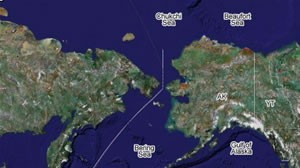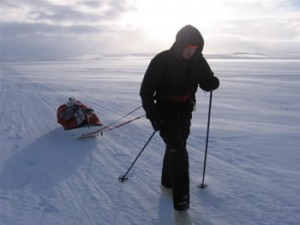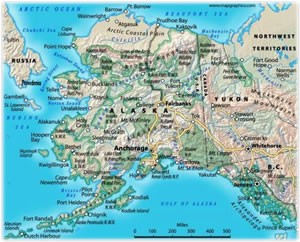Are you dreaming of an epic adventure that takes you from the wilds of Alaska to the vast landscapes of Russia? The question, “Can You Travel From Alaska To Russia,” is more complex than it appears at first glance, and TRAVELS.EDU.VN is here to guide you through the realities of this incredible journey. While a direct route across the Bering Strait presents significant challenges, both legal and logistical, there are ways to make this dream a reality with careful planning and the right resources. Discover the best options, including alternative routes and expert tips, to turn your transcontinental travel aspirations into an unforgettable experience.
1. Understanding the Bering Strait: The Gateway Between Continents
1.1. Geographical Overview of the Bering Strait
The Bering Strait, a narrow passage of water separating Alaska and Russia, represents the physical connection between North America and Asia. At its narrowest point, the strait is approximately 51 miles (82 kilometers) wide, located between Cape Dezhnev in Russia and Cape Prince of Wales in Alaska. This proximity has intrigued explorers and travelers for centuries, sparking interest in the possibility of crossing between the two continents.
1.2. The Diomede Islands: Stepping Stones in the Bering Strait
The Diomede Islands, consisting of Big Diomede (Russia) and Little Diomede (USA), lie in the middle of the Bering Strait. Just 2.4 miles (3.8 kilometers) separate these islands, with the International Date Line running between them. Little Diomede has a small community, whereas Big Diomede is primarily a military base. These islands sometimes serve as theoretical stepping stones, but the maritime conditions and international border restrictions make any crossing extremely difficult and highly regulated.
1.3. Historical Significance of the Bering Strait
Historically, the Bering Strait region is believed to have been a land bridge, known as Beringia, during the last Ice Age. This land bridge facilitated the migration of early humans from Asia to North America. This deep historical context enriches the allure of the area for those fascinated by human history and migration patterns.
2. Is It Possible to Travel Directly Across the Bering Strait?
2.1. The Challenges of Crossing by Land or Ice
While the idea of walking or driving across the Bering Strait is captivating, the practicalities are daunting. The strait rarely freezes completely, and even when it does, the ice is unstable and unpredictable due to strong currents and shifting ice floes. According to a study by the National Oceanic and Atmospheric Administration (NOAA), the average water temperature in the Bering Strait is around 38-44°F (3-7°C), making it a challenging environment for ice formation. Therefore, crossing by foot or vehicle is highly dangerous and generally not feasible.
2.2. Navigating the Bering Strait by Boat or Ferry
Crossing the Bering Strait by boat presents its own set of challenges. The waters are notoriously treacherous, with unpredictable weather patterns, strong currents, and frequent storms. Smaller boats, such as kayaks, can attempt the crossing during calm weather, but require significant expertise and a support vessel. Ferries do not currently operate between Alaska and Russia due to political and logistical complexities.
2.3. Legal and Political Restrictions on Border Crossing
One of the most significant barriers to crossing the Bering Strait is the complex web of legal and political restrictions. Both the United States and Russia have strict border controls, and unauthorized crossings are illegal and can result in severe penalties. Securing permission to cross, even with proper documentation, is exceedingly difficult due to geopolitical tensions and security concerns.
 Map of the Bering Strait showing the proximity of Alaska and Russia
Map of the Bering Strait showing the proximity of Alaska and Russia
The Bering Strait, separating Alaska and Russia, presents formidable geographical and political challenges to cross.
3. Alternative Routes and Legal Options for Traveling Between Alaska and Russia
3.1. Flying: The Most Convenient Way to Travel
The most straightforward and practical way to travel between Alaska and Russia is by air. Several airlines offer flights from Anchorage, Alaska, to major cities in Russia, such as Moscow or Vladivostok, with connections to other destinations. While this option lacks the adventurous appeal of crossing the strait directly, it is safe, reliable, and relatively efficient.
3.2. Maritime Travel via Official Ports
Another legal, albeit more complex, option is to travel by sea to an official port of entry. In Russia, Provideniya is the closest port to Alaska. However, gaining permission to arrive in a small vessel requires extensive paperwork, including a Russian visa, a “Rasporyazheniye” (a special permit for visiting Chukotka), and approval from the Russian Coast Guard. This process can take up to a year and requires a local sponsor to vouch for you.
3.3. Connecting Flights Through Other Countries
Travelers can also opt for connecting flights through other countries, such as Canada or countries in Europe and Asia. This approach involves flying from Alaska to a major international hub and then catching a connecting flight to Russia. Although it may take longer, it can sometimes be more cost-effective and offer additional travel opportunities.
4. Required Documentation and Permits for Legal Travel
4.1. Obtaining a Russian Visa
A Russian visa is essential for any legal travel to Russia. The type of visa required depends on the purpose of your visit, whether it be tourism, business, or study. The application process involves submitting a detailed application form, a valid passport, a letter of invitation, and other supporting documents to the Russian consulate.
4.2. The Elusive “Rasporyazheniye” Permit
The “Rasporyazheniye” is a special permit required for visiting Chukotka, the northeasternmost region of Russia. Obtaining this permit is notoriously difficult and requires a local sponsor who is registered with a special division of the government. This sponsor must vouch for you and assist in navigating the bureaucratic process.
4.3. Navigating Communication and Customs Regulations
Effective communication with Russian authorities is crucial for a successful visit. Upon arrival, travelers must declare any communication devices, such as cell phones and GPS devices, and obtain special permits for their use. Failure to do so can result in confiscation of these items. Additionally, adherence to customs regulations is essential to avoid any legal issues.
5. Experiencing the Unique Cultures of Alaska and Russia
5.1. Cultural Insights of Alaskan Native Communities
Alaska is home to a diverse range of Native communities, each with its own unique traditions, languages, and customs. Visiting these communities offers a glimpse into the rich cultural heritage of the region. For example, the Inupiat people of northern Alaska are known for their traditional whaling practices and intricate artwork made from whalebone and ivory.
5.2. Exploring the Cultural Heritage of Chukotka
Chukotka, the Russian region facing Alaska, is also home to indigenous peoples with distinct cultures. The Chukchi and Yupik peoples have traditionally relied on reindeer herding and marine mammal hunting for sustenance. Visitors to Chukotka can learn about their traditional way of life through cultural centers and local festivals.
5.3. Opportunities for Cultural Exchange
Despite the political barriers, there are opportunities for cultural exchange between Alaska and Russia. Organizations like the Bering Straits Foundation facilitate educational and cultural programs aimed at fostering understanding and cooperation between the two regions. Participating in these programs can provide a deeper appreciation of the shared heritage of the Bering Strait region.
 Traditional Yupik dancers in Alaska
Traditional Yupik dancers in Alaska
Experiencing the cultural heritage of the Yupik people offers a unique insight into the traditions of the Bering Strait region.
6. Adventure Travel and Ecotourism Opportunities
6.1. Wildlife Viewing in the Bering Strait Region
The Bering Strait region is a haven for wildlife enthusiasts. The area is home to a variety of marine mammals, including whales, seals, and walruses, as well as seabirds such as puffins, auklets, and murres. Guided tours and wildlife cruises offer opportunities to observe these animals in their natural habitat.
6.2. Hiking and Trekking in Remote Landscapes
For those seeking adventure on land, the rugged landscapes of Alaska and Chukotka offer endless opportunities for hiking and trekking. From the tundra of the Arctic coast to the mountains of the interior, the region provides stunning vistas and challenging trails for experienced hikers.
6.3. Sustainable Tourism Practices
When traveling in the Bering Strait region, it is essential to practice sustainable tourism. This includes respecting local cultures, minimizing environmental impact, and supporting local businesses. By traveling responsibly, visitors can help preserve the natural and cultural heritage of this unique region for future generations.
7. Planning Your Trip: Tips and Considerations
7.1. Best Time to Visit Alaska and Russia
The best time to visit Alaska and Russia depends on your interests. Summer (June-August) offers the warmest temperatures and longest daylight hours, making it ideal for outdoor activities like hiking and wildlife viewing. Winter (November-March) provides opportunities for winter sports like skiing and snowmobiling, as well as viewing the Northern Lights.
7.2. Essential Packing List for an Arctic Adventure
Packing for a trip to the Arctic requires careful consideration. Essential items include warm layers of clothing, waterproof outerwear, sturdy hiking boots, a hat, gloves, and sunscreen. It is also important to bring insect repellent, as mosquitoes and other biting insects can be prevalent during the summer months.
7.3. Health and Safety Precautions
When traveling in remote areas, it is essential to take health and safety precautions. This includes consulting with your doctor about necessary vaccinations and medications, carrying a well-stocked first-aid kit, and being aware of potential hazards such as wildlife encounters and extreme weather conditions. It is also advisable to purchase travel insurance that covers medical emergencies and evacuation.
8. The Role of TRAVELS.EDU.VN in Facilitating Your Journey
8.1. Expert Travel Planning and Consultation
TRAVELS.EDU.VN specializes in creating unique and personalized travel experiences. Our expert travel planners can assist you in designing a customized itinerary that meets your specific interests and budget. We provide comprehensive consultation services, including assistance with visa applications, permit procurement, and logistical arrangements.
8.2. Tailored Tour Packages and Itineraries
We offer a variety of tailored tour packages and itineraries that showcase the best of Alaska and Russia. Whether you are interested in wildlife viewing, cultural immersion, or adventure travel, we have a tour package that is perfect for you. Our itineraries are designed to provide you with an authentic and unforgettable travel experience.
8.3. Ensuring a Seamless and Memorable Experience
At TRAVELS.EDU.VN, we are committed to ensuring that your travel experience is seamless and memorable. We handle all the details, from booking flights and accommodations to arranging transportation and activities, so you can relax and enjoy your trip. Our goal is to provide you with exceptional service and create a travel experience that exceeds your expectations.
9. Real-Life Travel Stories: Inspiring Journeys
9.1. Tales of Adventurers Crossing the Bering Strait
The history of the Bering Strait is filled with tales of daring adventurers who have attempted to cross its icy waters. From early explorers seeking new lands to modern-day adventurers pushing the limits of human endurance, these stories inspire and captivate. While many attempts have ended in failure, the spirit of exploration continues to drive those who seek to conquer this challenging passage.
9.2. Cultural Exchange Programs: Building Bridges
Cultural exchange programs have played a vital role in building bridges between Alaska and Russia. These programs bring together students, artists, and community leaders from both regions to share their cultures and learn from one another. By fostering understanding and cooperation, these programs help to overcome political barriers and promote peace and goodwill.
9.3. Ecotourism Initiatives: Preserving the Environment
Ecotourism initiatives are helping to preserve the fragile environment of the Bering Strait region. These initiatives promote responsible travel practices that minimize environmental impact and support local communities. By engaging in ecotourism, visitors can contribute to the long-term sustainability of this unique ecosystem.
10. Staying Updated: News and Resources for Travelers
10.1. Latest Travel Advisories and Regulations
Staying informed about the latest travel advisories and regulations is essential for safe and trouble-free travel. The U.S. Department of State and the Russian Ministry of Foreign Affairs provide updated information on travel conditions, visa requirements, and security concerns. It is advisable to check these resources regularly before and during your trip.
10.2. Trusted Travel Blogs and Forums
Travel blogs and forums can provide valuable insights and tips from fellow travelers. These online communities offer firsthand accounts of travel experiences, as well as advice on everything from packing and budgeting to navigating local customs and etiquette.
10.3. Connecting with TRAVELS.EDU.VN for Real-Time Updates
TRAVELS.EDU.VN is your trusted source for real-time updates and expert advice on traveling between Alaska and Russia. Subscribe to our newsletter and follow us on social media for the latest news, travel tips, and special offers. Our team is always available to answer your questions and assist you in planning your dream trip.
 Whales breaching in the Bering Sea
Whales breaching in the Bering Sea
The Bering Strait region teems with marine life, offering incredible opportunities for wildlife viewing and ecotourism.
FAQ: Your Questions Answered About Traveling from Alaska to Russia
1. Can I walk across the Bering Strait in winter?
While it’s theoretically possible during winter, the Bering Strait rarely freezes solid. Unpredictable ice conditions, strong currents, and legal restrictions make it highly dangerous and illegal.
2. Is there a ferry service between Alaska and Russia?
No, there is currently no ferry service operating between Alaska and Russia due to political and logistical complexities.
3. What documents do I need to travel to Russia from Alaska?
You need a valid passport, a Russian visa, and potentially a “Rasporyazheniye” permit for visiting certain regions like Chukotka. Also, be prepared to declare all communication devices.
4. How can I get a Russian visa?
Apply at the Russian consulate with a valid passport, application form, invitation letter, and supporting documents. The process can take several weeks to months.
5. What is a “Rasporyazheniye” permit and how do I get one?
It’s a special permit required for visiting Chukotka, Russia. You’ll need a local sponsor registered with the government to vouch for you and assist with the application.
6. What is the best time to visit Alaska and Russia?
Summer (June-August) offers warm temperatures and long daylight hours for outdoor activities. Winter (November-March) is ideal for winter sports and viewing the Northern Lights.
7. What should I pack for a trip to the Arctic?
Pack warm layers, waterproof outerwear, sturdy hiking boots, hats, gloves, sunscreen, and insect repellent.
8. Are there any cultural exchange programs between Alaska and Russia?
Yes, organizations like the Bering Straits Foundation facilitate educational and cultural programs to promote understanding and cooperation.
9. How can TRAVELS.EDU.VN help me plan my trip?
TRAVELS.EDU.VN offers expert travel planning, customized itineraries, assistance with permits, and ensures a seamless and memorable travel experience.
10. What health and safety precautions should I take?
Consult your doctor for vaccinations, carry a first-aid kit, be aware of wildlife and weather hazards, and purchase travel insurance.
Conclusion: Embark on Your Transcontinental Adventure
The journey from Alaska to Russia is a captivating dream that can be realized with careful planning and the right resources. While direct crossings of the Bering Strait present significant challenges, alternative routes, legal options, and expert guidance from TRAVELS.EDU.VN can turn your aspirations into an unforgettable adventure. Whether you choose to fly, travel by sea, or participate in cultural exchange programs, the experience promises to be enriching and transformative.
Ready to start planning your trip? Contact TRAVELS.EDU.VN today at 123 Main St, Napa, CA 94559, United States, or via Whatsapp at +1 (707) 257-5400. Let our expert team create a personalized itinerary that meets your specific interests and budget. Don’t wait any longer—embark on your transcontinental adventure and discover the unique cultures and stunning landscapes of Alaska and Russia with TRAVELS.EDU.VN! Visit our website at travels.edu.vn for more information and to book your unforgettable journey. Discover the allure of transcontinental travel with our expert guides. Let us make your dream a reality!